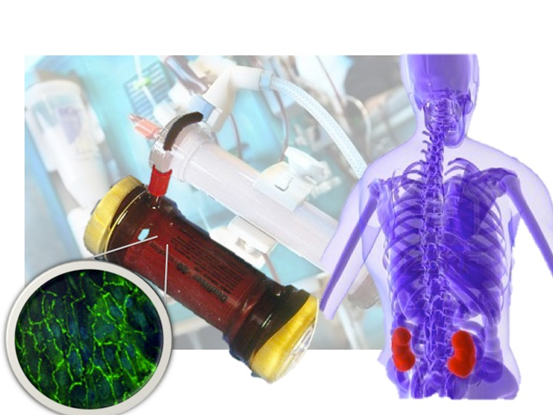Researchers at the MIRA research institute of the University of Twente and the Radboudumc have created a 'living membrane' combining kidney epithelial cells with a polymeric artificial membrane. This achievement is a first but significant step towards development a new treatment for kidney patients. This research, which started within the BMM - BioKid project (2009-2014), it is currently continued within the EU Marie Curie ITN project 'Bioart'. The aim is achieving improved dialysis techniques and possibly leading to development of a portable kidney, or even an implantable artificial kidney. This collaborative research, of the groups of Prof. Dr. D. Stamatialis in MIRA and Dr R. Masereeuw at Radboudumc, has been published in the scientific journal Acta Biomaterialia.
In the Netherlands, there are approximately 40.000 kidney patients from whom around 12.000 patients require renal replacement therapy and 6.500 patients are dialyzed three to four times a week. A kidney transplant is often the best solution for these patients, but the waiting list is long – around five years. Each year 200 patients die because a donor kidney did not arrive in time for them.
While dialysis therapy has already prolonged many patients' lives, the treatment cannot completely replace renal function. Mortality (15-20% per year) and morbidity of these patients remain high, whereas their quality of life is generally low. Dialysis therapy removes mainly small, unbound substances from the circulation, while leaving large, and protein-bound uremic solutes untouched.
Throughout the world researchers are working on improved therapies in order to remove a broader range of toxins from the blood. Within this context, researchers at the University of Twente and the Radboudumc have made an important contribution. They have developed a 'living membrane' comprised of living kidney cells on a polymeric membrane. Some of the challenges they faced were to develop an optimal coating for the membrane onto which the living cells could form a functional monolayer as well as the optimization of the cell culture conditions. Developing such a membrane is a small but important step in the research. Future work will be directed towards producing 'living membranes' on fibers and to evaluate an up-scaled system to develop a clinically relevant device.
More information: "Development of a living membrane comprising a functional human renal proximal tubule cell monolayer on polyethersulfone polymeric membrane," Acta Biomaterialia, Volume 14, 1 March 2015, Pages 22-32, ISSN 1742-7061, dx.doi.org/10.1016/j.actbio.2014.12.002
Journal information: Acta Biomaterialia
Provided by University of Twente





















